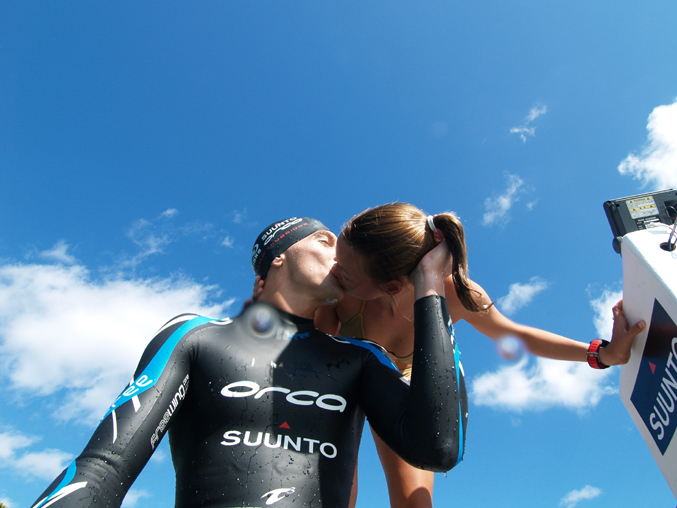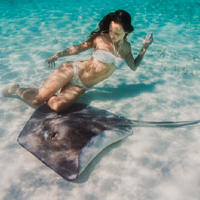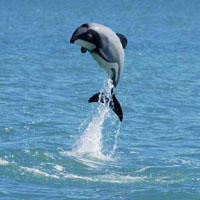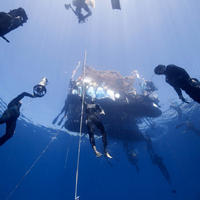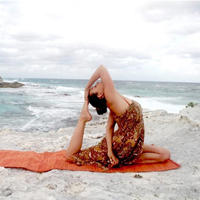William and Brittany Trubridge. Photo by Igor Liberti
Brittany and William Trubridge are masters at two very different practices: yoga and freediving. Yet they’ve found the synergies between their passions, and they take turns sharing their expertise with people who come for her yoga and his freediving workshops at their home base in Long Island, the Bahamas, and throughout Europe. Brittany shares the delights of practicing yoga in secret caves and on sand bars during her nature-based yoga workshops and William introduces her students to freediving, an extreme sport that requires divers to breath-hold dive into the abyss to retrieve markers. Students in William’s elite Vertical Blue freediving school find the calming breath and meditation techniques that Brittany’s yoga segment offers helpful in controlling their breathing and their minds in the water. Linking and sharing her passion with William’s, Brittany says, “is one of the sweetest things we do for each other.”
Brittany and William share another passion, for cleaning up the oceans and beaches that are their playground. For both William and Brittany, the sea is a sensual gift, a place that washes away stress and connects them to their higher selves. They spend a lot of time training and practicing on beaches from the Caribbean to the Mediterranean, and they’re horrified at the amount of garbage they encounter. Determined to do something, they’ve organized extensive beach cleanups in the Caribbean that have collected literally tons of plastic.
William’s other cause, saving the critically endangered Maui’s dolphin that is native to New Zealand, where he grew up. The Maui’s dolphin population has plummeted from 2,000 in 1970 to 55 today. The species has become a poster child for “bycatch”—sea life that gets caught and drowns in fishing nets. William learned to love the ocean in New Zealand, and he’s appalled that obsolete fishing regulations have allowed the sea mammal to come so close to extinction.
“Hector’s Dolphins are the smallest and rarest dolphins in the world,” William says. “They’re intelligent, friendly and beautiful, and they only live in New Zealand. Maui’s are a sub-species of Hector’s that only live in a relatively small habitat territory on the West Coast of the North Island, and they’re almost gone. Under existing laws, the species will be extinct by 2030, and the New Zealand government is apathetic if not downright anti-ecological.”
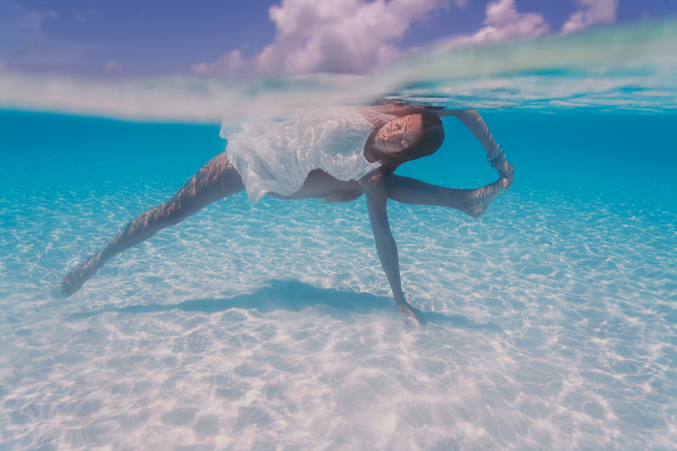
Brittany Trubridge ♥ “William has taught me how to be dedicated, disciplined, and patient—and to show up, no matter what. Show up and give it all you’ve got.” – Brittany Trubridge Photo by Elena Kalis)
BRITTANY TRUBRIDGE
You and William teach in other’s training retreats. What have you learned from him?
William has taught me how to be dedicated, disciplined, and patient—and to show up, no matter what. Show up and give it all you’ve got.
Tell me about your yoga retreats.
Our Caribbean Yoga Retreats are about getting outside into nature and experiencing nature’s elements. Our weekly calendar changes according to the tides and the weather, and we have daily eco-excursions like a cave tour and practicing yoga in the cave and an eco-boat tour where we go out to a sand bar in the middle of the sea to practice yoga. It’s a very sensual approach. We practice on the beach, soaking in the sun with gentle waves lapping in and over and around our bodies.
What inspires the approach you take in your retreats?
Gratitude. We’re interested in expressing gratitude—for this amazing planet, for the miracle of life, and for being alive and part of that miracle. The idea is to sync the body, mind and spirit with nature by getting into the water, out onto the sandbars and beaches, into the caves and saying, “thank you!” through yoga.
Your underwater yoga photography is spectacular. What does it feel like to take an asana below the surface?
Incredible! In the sea you are weightless, and when you are underwater you are also holding your breath, which stills the mind. Without gravity we are able to enter and soften more comfortably into an asana than on land. We can’t hold the posture quite as long, but there is a spark of magic that happens in that brief time. There is complete stillness, effortlessness and joy.
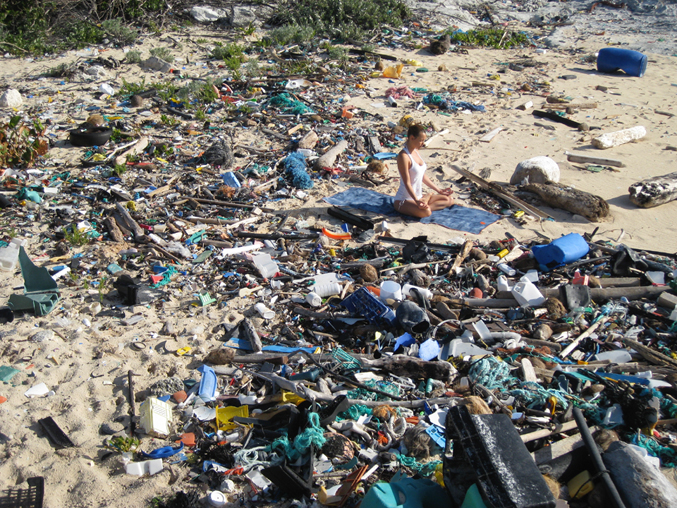
Brittany Trubridge ♥ “There’s already so much plastic trash in the world—rebirthing some of it into conscious lifestyle products is another way to elevate the karma.” - Brittany Trubridge (Photo courtesy Manduka)
What is the story behind the photo of you practicing yoga on the beach covered with trash?
This is one of the most beautiful beaches on our island, but it is covered with plastic trash that has washed up from the sea. I wanted to raise awareness of what plastic pollution can do to beautiful places like this. That’s a Yogitoes mat towel that I'm practicing on. It is made from recycled plastic bottles—seven, to be precise. I wanted to demonstrate how trash can be turned into treasure and how we can be peaceful warriors by taking small actions like supporting companies and people who are taking this sort of initiative.
How do you feel when you’re on a beach covered with plastic trash?
I feel overwhelmed with sensory overload. There's a lot of energy imprinted on the individual trash items, and each piece has a story. Someone brushed their teeth with that toothbrush, someone drank out of that cup, some little boy threw that ball, some little girl played with that sand bucket. I sense all of those stories and hear that chatter, and they’re out of place. They don’t belong there, and that’s—eerie. That's not what a beautiful beach is for. A beautiful beach is a place to cleanse your mind and wash away all the sensory input rather than overload you with it.
Many people don’t realize how deadly plastic can be to marine life.
Sea turtles and sea birds and whales and all sorts of beautiful sea creatures mistake our plastic trash for food and eat it, and it kills them. Not hundreds, but hundreds of thousands of marine animals, including close to 300 that are classified as endangered, die every year because of this. This is happening all over the world, and it breaks my heart.
Sometimes I feel so frustrated and helpless because the problem is so huge—but we can’t give up. I try to set a living example with lifestyle choices, hoping that it has a trickle-down effect. With the many beach clean-ups William and I have organized, we’ve cleaned up literally tons of plastic trash from the sea and shore. But with every wave, it just keeps on coming.
Is this why you choose to be a Yoga Ambassador for Yogasana mats?
Yes, this is what draws me to Yogasana and why I feel great supporting the brand. They last a lifetime, but they’re also completely biodegradable. Plus, they’re gorgeous, and they’re hand woven from natural materials, which makes a big difference, energetically, when practicing yoga.
Do you share William’s passion for New Zealand's critically endangered endemic dolphins?
Yes, very much so. I can't believe this is happening in 2014. I can't even comprehend it.
What are you are doing to help?
I do the best I can to raise awareness, and while awareness is key, it's not enough. We need voices—lots of loud voices—to really, truly be heard. I regularly share and post about the Maui’s dolphin via social media, blogs and newsletters in association with my personal yoga brand in order to reach the yoga community.
I also created the TruBlue Foundation as a way of helping to preserve, protect and respect the sea. It’s about representing the human connection to the sea and becoming one with the sea through yoga and freediving. Through TruBlue we’ve partnered with Prawno Apparel to create Maui’s dolphin t-shirt designs to raise funds. The design shows the last 55 Maui’s dolphins and together they form the shape of a Maui’s dolphin.
How do you feel about dolphins in general?
Dolphins are no different from us. They’re intelligent, intuitive, spiritual, emotional—all of it—just in a different shape. But as much as I love dolphins, I feel that every species on this Earth is equal and deserving of being here. It is our species that is wiping out others, so it is up to us to take a stand. We need to decide if we want to evolve in a noble direction, rather to continue down a destructive path that ends with multiple extinctions, if not mass extinction.
What would you say to the current New Zealand government if you could say one thing?
I would say, “Shame on you.”
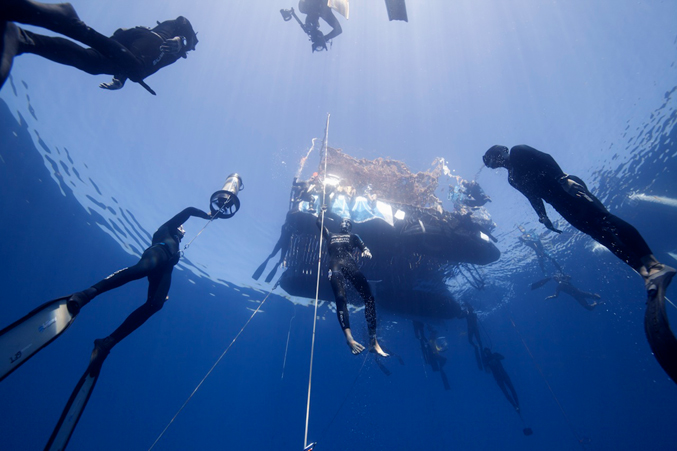
William Trubridge ♥ “Britta taught me how to find the “silent witness” during meditation—that part of you that is conscious and observant to every experience and thought but never intrudes or intervenes.” – William Trubridge (Photo by Daan Verhoeven)
WILLIAM TRUBRIDGE
You and Brittany teach in each other’s training retreats. What have you learned from her?
Britta taught me how to find the “silent witness” during meditation—that part of you that is conscious and observant to every experience and thought but never intrudes or intervenes.
There is clearly some meditation or yoga present in your freediving technique.
When I first began freediving in 2003, I began investigating and experimenting with different yogic exercises—mostly pradayama, which definitely has benefits. It improves breath holds by increasing tolerance to carbon dioxide and low oxygen. It also helps to create the mental control that’s necessary to stay relaxed within those sensations. It’s one thing to feel that urge to breathe and to be able to carry on and not take a breath, and it’s another thing to feel that urge and be able to stay completely calm and focused and therefore use less oxygen in your body so you can release your mind.
You’re passionate about helping the Hector and Maui’s dolphins.
They’re classified as critically endangered, which means they’re facing a real and present danger of being driven extinct, which means we can't afford to lose a single one.
When did they start keeping track?
1970—and since then the Hector’s dolphin populations have dropped from 30,000 to just over 7,000. That’s more than 75 percent. It’s even worse for Maui’s; in 1970 were 2000 and today there are only 55. There’ve been small gains for their protection, but nothing really significant and nothing that solves the problem.
Shocking! What motivates the New Zealand government?
Finances. Money. If we can prove that it is actually more profitable financially to protect the Maui’s dolphin than to allow it be rendered extinct for the sake of cheaper fish n’ chips, then maybe the species has a chance.
So, what can we do?
The greatest power we have as global consumers is to vote with our voices and our choices. If you were considering visiting New Zealand on holiday, I would encourage you to speak up for the Maui’s Dolphin to anyone associated with your travel plans. Let the airlines and hotels and restaurants you visit know you are aware of the situation and that you feel strongly about it. I’d even encourage you to consider choosing some other country where the government is actively preserving their environment and wildlife rather than continuing to engage in activities that put them at serious risk. And if you decided not to visit New Zealand for these reasons, then make sure to tell the government and whatever relevant bodies that you’ve made this decision because of their poor practices. Let them know it cost them money, because that seems to be all they’re interested in.
The issue of plastic pollution in oceans and on beaches all over the world—even super remote islands—is also important to you.
If people in the developed world aren't even aware that plastic isn't biodegradable—and many people aren't—imagine how poorly understood this problem must be in less-privileged nations, where the knowledge of how damaging plastic is on the environment is virtually non-existent. In less privileged countries it is common for fishing boats, for instance, to dump their trash overboard and for coastal villages to simply let their trash be swept out to sea.
Do you see wealthy nations playing a role in this?
Yes, I do, absolutely! The way they play into this problem should not be underestimated. Providing countries with plastic products, and/or the means to generate plastic, without giving them the awareness and the technology to recycle their plastics is, frankly, grossly irresponsible. Wealthy nations need to address the extremes of our plastic footprint to other countries who are attempting to follow in our footprints.
Some of the tourist-related plastic statistics are staggering. Is there any practical advice you’d like to share with travelers?
Plastic bottles and plastic bags are two major pollution offenders that are easily remedied with very little effort or cost. You can bring your own drinking bottle and refill it and carry a reusable bag for purchases you make along the way. Also, if I’m going into a supermarket and I’m at the checkout register and they’re about to put an item I’m buying into a double plastic bag, I let them know that I’ve brought my own, and I also explain why I’m making the choice. I think that last step is very important.
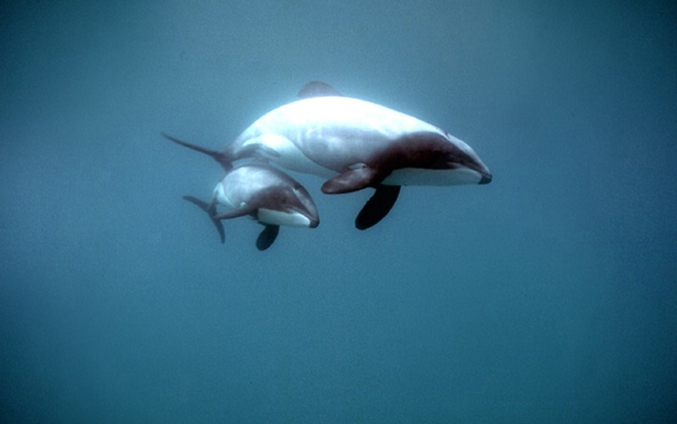
New Zealand’s Critically Endangered Maui’s Dolphin
The friendly, beautiful, intelligent Maui’s Dolphin (Cephalorhynchus hectori maui) lives only in the shallow western coastal waters of New Zealand’s North Island. The world’s smallest and rarest cetaceans, they are a genetically distinct subspecies of the Hector’s Dolphin (Cephalorhynchus hectori), which is found only around the South Island. Maui’s are classified as critically endangered, and Hector’s are classified as endangered. Both are in serious trouble.
The primary threats to both Hector’s and Maui’s dolphins are gill set nets and trawl fishing. Expert reports estimate that approximately 150 Hector's and Maui's dolphins die in commercial and recreational set nets every year. Secondary threats include boat strikes, pollution and developments along New Zealand’s coastline. Overfishing, aquaculture, gas and oil exploration, and offshore irons and mining are also serious threats to their vital habitat.
The New Zealand government relies heavily on tourism and exports, including organic produce and premium lifestyle products—so your voice counts. Letting them know that you are aware of the Hector’s and Maui’s dolphin situation and that you won’t buy anything from New Zealand until they’re properly protected is one of the best ways to help.
—END INTERVIEW—
LEARN MORE ABOUT NEW ZEALAND'S NATIVE DOLPHINS
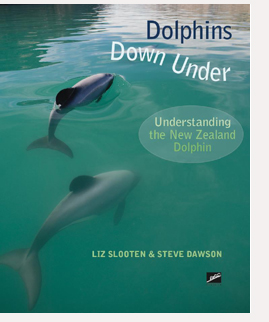 To learn more about the Hector’s and Maui’s Dolphin, check out Dolphins Down Under: Understanding the New Zealand Dolphin (Otago University Press, 2013), co-authored by Dr. Elisabeth “Liz” Slooten and Dr. Steve Dawson, scientific partners who have intensely studied New Zealand’s only endemic dolphins for more than 30 years. To support their work, please visit New Zealand Whale and Dolphin Trust, the leading authority on the Hector's and Maui's Dolphin and the only group actively researching their conservation.
To learn more about the Hector’s and Maui’s Dolphin, check out Dolphins Down Under: Understanding the New Zealand Dolphin (Otago University Press, 2013), co-authored by Dr. Elisabeth “Liz” Slooten and Dr. Steve Dawson, scientific partners who have intensely studied New Zealand’s only endemic dolphins for more than 30 years. To support their work, please visit New Zealand Whale and Dolphin Trust, the leading authority on the Hector's and Maui's Dolphin and the only group actively researching their conservation.
New Zealand is already infamous for wiping out the Moa (Dinornis robustus) and the Haast's Eagle (Harpagornis moorei). The Maui's Dolphin (Cephalorhynchus hectori maui) would be the third human-caused extinction in New Zealand. It would be the first marine dolphin to go extinct at the hands of humans. Even during the great whaling era, humans didn’t quite manage to completely wipe out any whale or dolphin species.
“What is it about the words ‘critically endangered’ that the decision-makers don't understand? This extinction is totally avoidable.” - Dr. Elisabeth “Liz” Slooten
Zoe Helene (zoehelene.com) is a media correspondent and advocate for women, wildlife and wilderness. She spent 10 influential years growing up in Aotearoa, the Maori word for New Zealand, which means The Land of the Long White Cloud. Zoe works with leading activists, scientists and environmental organizations across the globe to save species such as the critically endangered Maui's Dolphin and endangered Hector's dolphin from extinction. Hector’s and Maui’s are New Zealand's only native dolphins. Zoe, like the native Maori, considers them taonga, a treasure to protect and cherish.
ONLINE RESOURCES
Brittany Trubridge (www.BrittanyTrubridge.com)
Caribbean Yoga Retreats (www.CaribbeanYogaRetreat.com)
William Trubridge (WilliamTrubridge.com)
Vertical Blue (www.VerticalBlue.net)
Hector's and Maui's Dolphins (HectorsDolphins.com)
NABU International (www.gofundme.com/Mauis-Dolphin-LDF)
Hector's and Maui's Dolphin SOS (www.facebook.com/groups/hectorsandmauissos)
TruBlue Foundation (www.facebook.com/TruBlueFoundation)
Yogasana (www.YogasanaMats.com)
Prawano Apparel (www.prawnoapparel.com)
PHOTO CREDITS
Photos of William freediving are by Daan Verhoeven (DaanverHoeven.com)
Photos of Brittany practicing yoga in the water are by Elena Kalis (ElenaKalisPhoto.com)
Photo of Brittany practicing yoga on the rock formations in CapoTesta, Sardinia is by William Trubridge (WilliamTrubridge.com)
Photos of Maui’s Dolphins are by Steve Dawson (WhaleDolphinTrust.org.nz)
